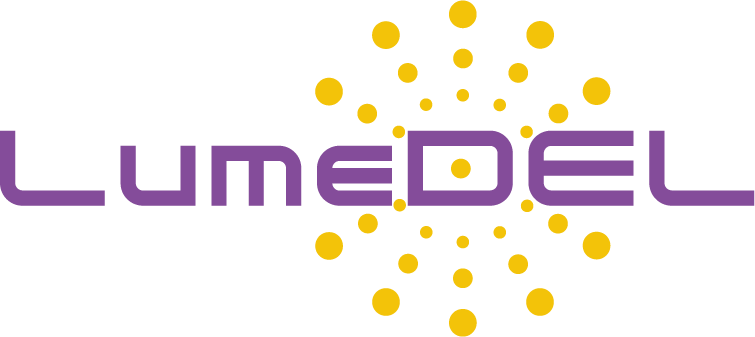Glossary of Terms
absorption – a process where light energy is converted to another form of energy.
cladding material – one or more layers of materials of lower refractive index in intimate contact with a core material of higher refractive index.
coherence – a fixed phase relationship between the electric field values at different locations or at different times.
collimation – a collimated beam of light has parallel rays, and therefore will spread minimally as it propagates.
constant current – In driving LEDs, higher current operation increase the LED radiance. A constant, regulated current prevents the LED from drawing more current than its rated maximum which would damage the LED.
core material – the core is the central light-carrying portion of an optical fiber.
cosine law – For a Lambertian source, the radiant intensity decreases by the cosine of the view angle.
diffuse reflector – diffuse reflection is the reflection of light from a surface such that an incident ray is reflected at many angles, rather than at just one angle as in the case of specular (mirrorlike) reflection.
beam divergence – in optics, beam divergence is the increase in beam diameter with distance from the emitting optical aperture.
étendue – étendue describes a property of an optical system, which characterizes how "spread out" the light is in both area and angle. It explains the flux transfer characteristics of an optical system. The smallest étendue in the system limits the light flux throughput.
FGS – Fluorescence Guided Surgery (FGS) uses fluorescently labelled markers to display tumors with contrasting pseudo-colors allowing more precise tumor resection while preserving healthy tissue.
fluorescence – the absorption of radiation at one wavelength (excitation) followed by reradiation usually at a longer wavelength (emission).
fluorescence microscopy – The use of a special microscope to see objects that give off fluorescent light. Prominently used in life sciences in the study of cell biology.
fNIRS – Functional near-infrared spectroscopy (fNIRS) use near-IR light (650–1000 nm) to noninvasively monitor tissue oxygenation. Since this light penetrates the cranial cavity, fNIRS has been used for brain function mapping.
Fresnel reflections – light reflections occurring at an interface between different optical media.
germicidal light – light that that destroys harmful microorganisms, usually emitting UV-C radiation.
index of refraction – a value calculated from the ratio of the speed of light in a vacuum to that in a second optical medium of greater density. It indicates the light bending ability of the medium and is wavelength dependent.
Lambertian – A light emitting or reflecting surface which obeys the cosine law of illumination is said to be Lambertian.
laser – LASER stands for Light Amplification by Stimulated Emission of Radiation. A laser is a coherent source of light, which means its photons are in phase. It produces a highly directional, low divergence beam of light.
LED – LED stands for Light Emitting Diode. LED is a non-coherent source of light, and its photons are out of phase. Its surface is a Lambertian light source emitting into many directions.
monochromatic – light consisting of radiation of a single wavelength, or of a very small range of wavelengths.
multimode fiber – a fiber with a core diameter of 50 µm or greater. A larger core allows multiple modes (or rays of light) to travel down the core.
NIRS – a spectroscopic method that uses the near-infrared region of the electromagnetic spectrum.
numerical aperture – the numerical aperture (NA) of an optical system is a dimensionless number that characterizes the range of angles over which the system can accept or emit light. It is the sine of the maximum half-angle.
optical fiber – a very thin strand of plastic or glass that is used to transmit light by total internal reflection.
optogenetics – involves using light to control biological cells and structures that have been genetically modified to incorporate photosensitive proteins.
PDT – In Photodynamic Therapy (PDT) light activates a drug that preferentially concentrates in tumor tissue, triggering a photochemical reaction that kills the cancer cells.
photoactivation – the activation or control of a chemical, chemical reaction, or organism by light.
photobiomodulation – is defined as a form of light therapy that utilizes non-ionizing light sources. Endogenous chromophores react to light causing beneficial photochemical reactions in cells for the relief of pain.
photocatalyst – a photocatalyst is a photoactive material that facilitates a chemical reaction by contributing energy harvested from incident light.
photopolymerization – photopolymerization is technique that involves the solidification of photo-sensitive resin by means of light, typically at ultraviolet or visible (blue) wavelengths.
radiance – the radiant intensity emitted from a known unit area of a source.
radiant flux – the total optical power from a source, the fundamental unit of radiometry.
Rayleigh scatter – the scattering of light by particles that are very small in relation to the wavelength of the light.
reflectance – the proportion of light or other radiation striking a surface which is reflected off it, a measured unit-less quantity.
solid angle – a 3D angular volume that is defined analogously to the definition of a plane angle in two dimensions.
spectroscopy – the analysis of the interaction between matter and any portion of the electromagnetic spectrum.
step index – a type of optical fiber having a uniform core with one index of refraction, and a uniform cladding with a smaller index of refraction propagating light by total internal reflection.
total internal reflection – occurs when light incident on the boundary between two transparent media is fully reflected if the light is coming from the optically denser medium and the angle of incidence is greater than the critical angle for both materials involved.
transmittance – the proportion of light or other radiation striking a surface which is transmitted through it, a measured unitless quantity.
TTL – Transistor-Transistor Logic, a hardware protocol for data transfer by serial communication.
UV-C – the highest energy portion of the UV radiation spectrum, with wavelengths of 200 – 290 nm.
